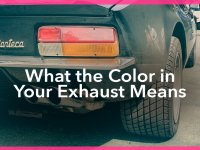If you own a car with a modern diesel engine dated 2008 or newer, your vehicle shouldn’t emit any smoke while your vehicle is running. Modern diesel engines have exhaust after-treatment systems that prevent this from happening. Even older car engines dated pre-2008, which do not have exhaust after-treatment systems, should emit only a small amount of smoke.
A little white smoke isn’t anything to be worried about. You’ll likely see white smoke shortly after you start your engine during colder temperatures. After a few minutes, your engine will reach its average running temperature, and the smoke should dissipate. Other than this scenario, you shouldn’t see any other smoke come from your exhaust. If you notice smoke of any color coming from your car’s exhaust, take your vehicle in to see a mechanic who specializes in diesel and auto repairs.
Different colors of exhaust smoke are indicative of different issues. Learning what different smoke colors mean will help you better identify your engine’s problem. Let’s take a look at the most common smoke colors and the issues they represent.
Black Smoke
If your car emits smoke that is black or dark grey, there is partly-burned fuel blowing out of your car’s combustion chamber. If your car’s fuel is only burning partially, you may have overloaded fuel into your vehicle. Black smoke is also a sign that your car engine doesn’t have enough air for proper combustion. This may also mean that there isn’t enough time given to burn the fuel.
When your car emits black smoke, you may notice that your car is lacking power or that you’re having problems with fuel economy. Taking your car in for repairs will help to alleviate these issues and improve your engine’s performance.
White Smoke
White smoke is a result of unburned fuel particles passing through your car’s combustion chamber and out of the exhaust pipe. As previously mentioned, white smoke is related to lower temperatures in the combustion chamber. When the chamber isn’t hot enough, some fuel particles fail to ignite. Don’t worry too much if you see white smoke in colder climates. Your car’s engine will warm up as you drive, and your combustion chamber will begin to burn all of the passing fuel particles.
Blue Smoke
If your car emits blue smoke, there is engine oil burning in your combustion chamber. This could be due to worn out piston rings, broken valve sleeves, or failed turbocharger seals. In cases of blue smoke, auto repair professionals usually opt to run a compression test on the car’s cylinders. If the car passes the test, they then look into the car’s turbo intake piping to check for oil.
Excessive diesel engine smoke is never a good sign. But knowing what these different smoke colors mean can help you figure out the source of the dilemma more quickly. If your car’s exhaust begins to smoke excessively, contact our team at All in the Wrist to book an appointment. Your wallet and the environment will thank you!





